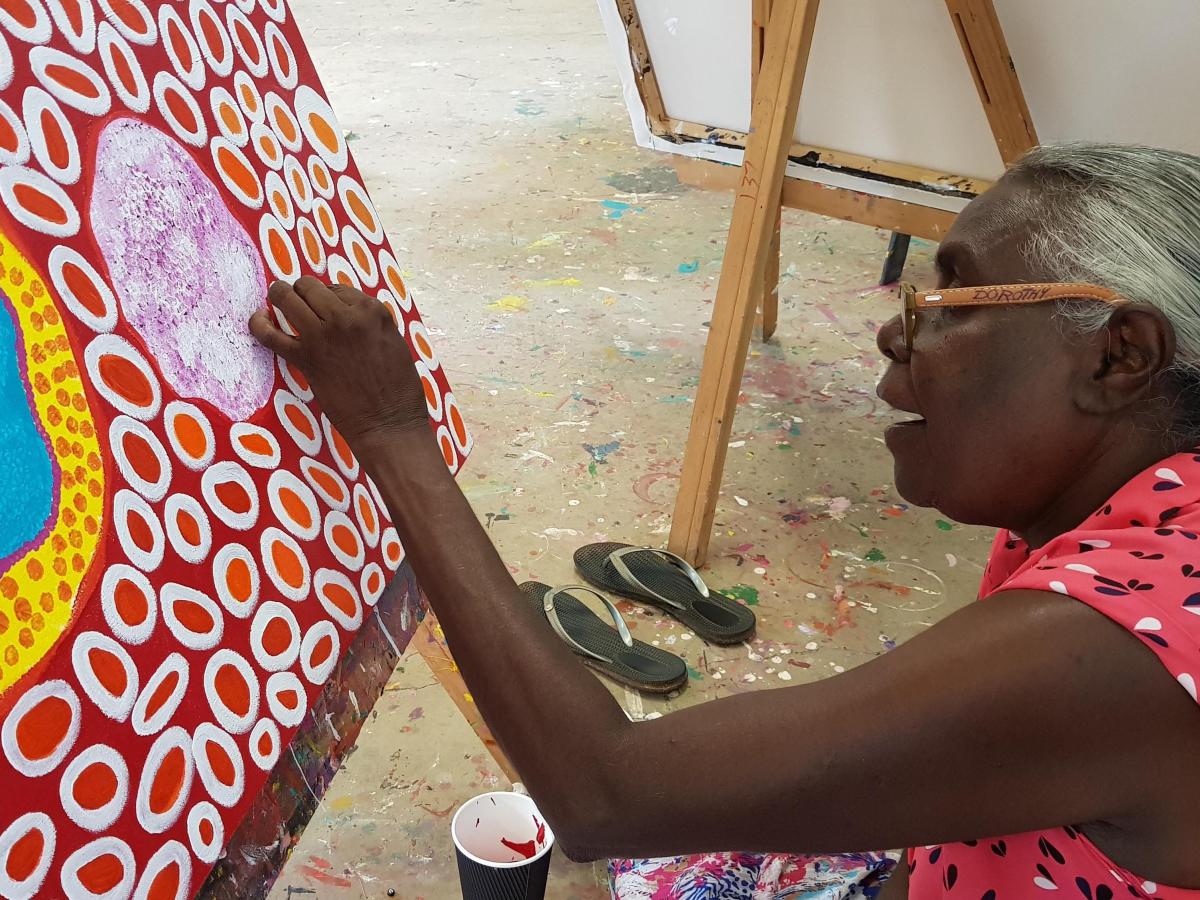Mornington Island artist Dorothy Gabori; image supplied.
Established in 2005, Mornington Island Art Centre (MIArt or Mirndiyan Gununa) is an Aboriginal art centre that has recently enjoyed an exciting period of regeneration and rejuvenation. Located in Queensland’s remote Gulf of Carpentaria, the art centre is fully owned and controlled by an Indigenous Board and most of the staff are Indigenous. MIArt is dedicated to delivering locally relevant programs that ultimately produce internationally significant artworks by Indigenous artists.
‘These artists confidently tell their stories about their families and their deep-rooted connections to the Old People. This creates works of outstanding beauty and clarity because the culture is strong and central to everything,’ said manager John Armstrong.
The influence of the artists’ connections to Country and culture shines through in their artistic interpretations. The works are joyful and exuberant but often tinged with the sadness of personal and family histories that stretch back through time. These are contemporary works but they also reflect ancestral stories.
Mornington Island is remote and this remoteness means the artists concentrate heavily on cultural and spiritual subject matter. It also means they are largely immune to outside influences, allowing their art practices to develop organically and come out of their deepest experiences and beliefs.
‘The richness and vibrancy in this work, by both the established artists and the new generations of emerging artists sharing and learning together, show that living in a remote community doesn’t mean being out of touch,’ Armstrong said.
Language is integral to all creative activities at MIArt and the primary purpose of the Mirndiyan Gununa Aboriginal Corporation is to maintain and develop the cultures of the Lardil and Kaiadilt people by strengthening Community and promoting their unique Cultures to the rest of the world.
There is an energy and optimism in the MIArt studios that creates exciting and often experimental work. Many of the pieces are characterised by a vivid and colourful palette as well as semi-abstract and abstract lines, shapes and forms. The artists working here are making strong contemporary artworks, not just strong Aboriginal artworks.
The Mornington Island artists are still heavily influenced and connected to the land and culture in their artistic interpretations. But with their wholly contemporary feel, such works challenge stereotypical notions about Aboriginal art.
Mornington Island artists include Dolly Loogatha, Johnny Williams, Joelene Roughsey, Amy Loogatha, Amanda Gabori, and Dorothy Gabori. The forerunner of this movement was the late Mirdidingkingathi Juwarnda Sally Gabori whose work is in many important private and corporate collections. She was exhibited at institutions across Australia and abroad including New Zealand, France, and the Netherlands.
The paintings of Amanda Gabori featured in a major exhibition late last year at the Woolloongabba Art Gallery. Her artworks are celebrations of resilience and connection to Country and deal with the stuff of lived experience. They are representations of lived thoughts, of things that are carried as relics of thoughts past.
‘I paint because I love it and I love my Country. It’s a very special place with lots of good and not so good memories,’ said Gabori.
Mornington Island first came to prominence in the 1970s with the Dick Roughsey and Percy Trezise series of picture books for children. And in 1973, dancers from Mornington Island made a dramatic presence at the opening celebrations of Sydney Opera House with their unique conical feathered hats and powerful ceremonial body painting.
Aboriginal art such as this was largely unknown outside of their communities at the time. Dot painting on canvas and cross-hatching on bark was becoming recognised in some areas of Australia and a few Aboriginal artists were becoming known internationally. Mornington Island in the Gulf was still a hidden secret.
Today, the activity within Mornington Island Art Centre is captivating and exciting; the artists are constantly inspired by one another. They incorporate contemporary materials into their practices while also reflecting on the past and the bonds between traditional culture and land.
John Armstrong says those bonds are often at the heart of the creative process. ‘Some of our artists working in the studio are rescuing wandering memories and giving them a context, a new place to be that allows us, as viewers, to experience them and to use them to construct our own remembering.’
For further information, visit www.facebook.com/morningtonisland or email John Armstrong, manager, at miart@morningtonisland.com.au.





